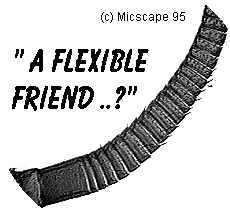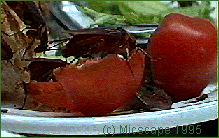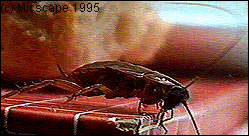

For some it is the thought of going to the dentist, for others it is spiders, injections, or the fear of madness or going blind. The microscope in its various disguises can help us examine these nightmares close-up. In this mini series, I will take you month by month, through some of our common nightmares. Did you think Microscopy was about quiet, studious, safe things? I hope not. 'Scoping' can take us nearer to beauty or closer to the savage truth of reality. For this month, let us consider a tiny friend (or is it fiend) that sometimes enjoys our food as much as us....

You wake during the night gasping for a glass of water.
Still numb from sleep, you stumble downstairs to the kitchen and
turn on the light... and freeze: the tiled floor is moving! The
cold tingle of fear consumes the residue of sleep and you are
alert - staring at the hundreds of black bugs scurrying rapidly
across the tiles to escape the light. With revulsion you realize
what they are: cockroaches.
These insects belong to the order Dictyoptera, sub-order Blattodea. Cockroaches are naturally found in countries with warm climates and those found in Europe and other colder habitats all over the world are actually living under artificial conditions - namely in our warmer homes and buildings. Man's commercial activities have inadvertently introduced these insects to non-tropical countries through his commercial trading and activities. They need food and warmth to survive. Where better for them to find these ideal conditions than in the artificial environment of our homes and buildings. Some common species are: 'black beetle' (Blatta orientalis), the American Cockroach (Periplaneta americana), and the German Cockroach (Blatella germanica). The world's most common cockroach is the American Cockroach which was taken to the United States inadvertently on slave ships from Africa. In fact, all cockroaches originated in this continent but were spread far and wide by the early trading ships.
 These insects are omnivorous.
They will not attack or kill each other for food but readily
consume any dead brothers and sisters or any other dead insect
material found in the wild. In our homes, they have a wide range
of tastes. They eat paper and scraps of food found in our
cupboards or on our tables - illustrated in the picture to the
left! Their sense of taste is so advanced that they can detect
the difference between food and poison by sampling a single
molecule of a substance.
These insects are omnivorous.
They will not attack or kill each other for food but readily
consume any dead brothers and sisters or any other dead insect
material found in the wild. In our homes, they have a wide range
of tastes. They eat paper and scraps of food found in our
cupboards or on our tables - illustrated in the picture to the
left! Their sense of taste is so advanced that they can detect
the difference between food and poison by sampling a single
molecule of a substance.
They have filthy habits - excreting where they run - and thereby contaminating our food. The possibility exists that they may spread several diseases: tuberculosis, cholera, leprosy, dysentery, and typhoid. Any contaminated food products must be thrown away and affected areas should be disinfected. The presence of cockroach infestation can also be detected by the strong foul odour left behind on the material they run across.
A quick word of warning. Before you go stamping on the next beetle you find crawling across your floor, take a moment to determine if it is indeed a cockroach. The majority of beetles are helpful to humankind, ridding us of unwanted pests in our gardens and crops. Some beetles may look like cockroaches to the casual and uninformed observer but few of them have the incredible flexible and long whip-like antennae of the latter. It is also well to remember that cockroaches are not actually beetles.
You might find putting the old boot down on one harder than you think. Their reflex actions are in the order of 1/50th second and therefore faster than human reflexes by about 5 times; and they know when you are coming: projecting from the back of a cockroach is the cerci, a finger-like organ covered with fine hairs which shimmer in the slightest air current - like the sound waves coming from your footsteps as you approach them. The sensory hairs are so finely tuned that that they can detect the 'sound' of other cockroaches walking nearby.
 As the title of
this nightmare suggests, the 'flexible friend' does not refer to
our relationship with the cockroach but to the flexible antennae
of the insect itself, and its usefulness as a sensing device. In
this picture you can see the antennae thrashing about like whips
as the cockroach searches the space at the edge of the table's
precipice in an attempt to locate firm ground! The flexible
properties of the cockroach antennae are derived from their
construction. If you go back to the opening image at the top of
this page, you can observe part of an antenna (feeler) greatly
magnified. It is made up of many segmented parts much like a
string of tiny cotton reels. This over-segmented arrangement
allows incredible flexibility.
As the title of
this nightmare suggests, the 'flexible friend' does not refer to
our relationship with the cockroach but to the flexible antennae
of the insect itself, and its usefulness as a sensing device. In
this picture you can see the antennae thrashing about like whips
as the cockroach searches the space at the edge of the table's
precipice in an attempt to locate firm ground! The flexible
properties of the cockroach antennae are derived from their
construction. If you go back to the opening image at the top of
this page, you can observe part of an antenna (feeler) greatly
magnified. It is made up of many segmented parts much like a
string of tiny cotton reels. This over-segmented arrangement
allows incredible flexibility.
Cockroaches possess two pairs of wings although these are often reduced in some females. Fortunately, most of these insects seem reluctant to fly even though they are capable of doing so. Their legs are short and slender which makes them excellent runners - as anyone who has tried to chase them will have found out. Fresh generations develop from eggs which are carried in a 'purse' (oothecae, plural) which is (in most species) deposited on the ground shortly after it is formed. Each 'purse' may contain between 12 to 50 eggs, depending on species. The hatched insects resemble tiny worms but quickly shed their skins to emerge as miniature cockroaches. Further moults (between 5 to 12) over a period of 2 to 18 months will see them develop into adults; the period depends on species.
Various treatments can be used to eradicate cockroaches from affected houses and buildings. Fumigation with hydrogen cyanide is used in some countries to clear-out heavily infested properties but cleaned premises may not stay cockroach-free for long. These insects will migrate from house to house, or flat to flat in multi-dwelling buildings, and cleansed areas may become re-infested from neighbouring houses if these remain untreated. Most of the materials used to treat cockroach infestation is highly poisonous. Proper professional help and methods must be employed to prevent harm to ourselves when attempting to eradicate this pest.
Although, we consider ourselves the most successful
creatures on planet Earth, it is wise to remember that insects
out-number us in every respect. They have spent far longer than
our few million years adapting to a variety of habitats, can
survive in extreme conditions where we would find it difficult,
and are more likely to survive any planetary catastrophe which
may lay waiting unknown in the future. It can only help
humankind's survival prospects to study and learn as much as
possible about all life-forms irrespective of our relationship
with them; friends or foes, we share the planet with them!
Comments to Maurice Smith.
Collins Field Guide: Insects of Britain & Northern
Europe (3rd Edition)
by Michael Chinery. ISBN 0-00-219918-1
Destructive and Useful Insects (4th Edition)
by C.L.Metcalf & W.P. Flint and revised by R.L.Metcalf
(ISBN 07-041658-3) Library of congress Catalogue Card Number
61-14049 published by Mcgraw-Hill Book Company 1962.
Lifesense by John Downer published by BBC books (1991) ISBN 0 563 36115 8
Images - Molcol Software from video film
taken at London Zoo, Insect House, Regents Park.
Please report any Web problems
or offer general comments to the Micscape Editor,
via the contact on current Micscape Index.
Micscape is the on-line monthly
magazine of the Microscopy UK web
site at Microscopy-UK